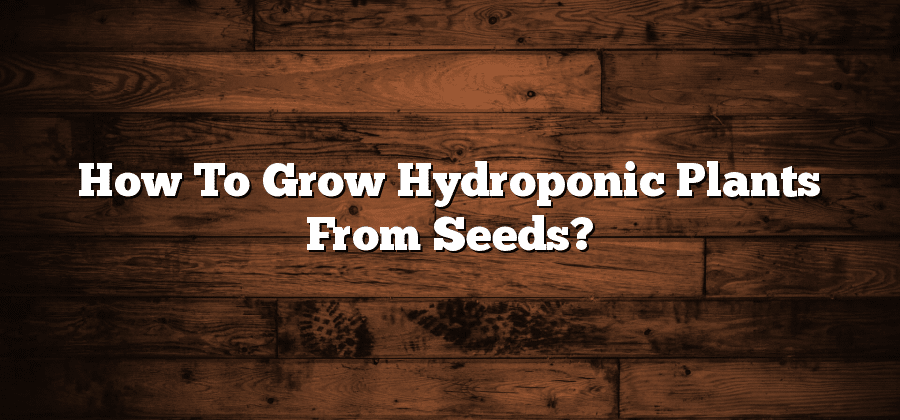Selecting the Right Seeds for Hydroponic Growth
Selecting the right seeds for hydroponic growth is a crucial step in ensuring a successful and thriving hydroponic system. When choosing seeds for hydroponics, it is important to consider the specific needs and requirements of the plants you wish to grow. Factors such as the plant’s growth habit, climate preferences, and nutrient requirements should all be taken into account.
One key consideration when selecting seeds for hydroponics is the variety of the plant. Certain varieties have been specifically bred for hydroponic systems and have traits that make them better suited for this type of cultivation. These varieties often have a more compact growth habit, which is beneficial as it allows for better space utilization in the hydroponic system. Additionally, some varieties may have increased disease resistance or improved nutrient uptake capabilities, making them more resilient in the controlled environment of a hydroponic system. By choosing seeds that are optimized for hydroponic growth, you can increase the chances of achieving optimal yields and harvest quality.
Understanding the Basics of Hydroponic Systems
Hydroponic systems are gaining popularity among both home gardeners and commercial growers. This innovative method of growing plants eliminates the need for soil, allowing plants to thrive in a nutrient-rich water solution instead. Understanding the basics of hydroponic systems is essential for anyone interested in exploring this modern approach to gardening.
One key component of a hydroponic system is the reservoir, which holds the water and nutrient solution that nourishes the plants. This reservoir is typically equipped with a pump to circulate the solution and provide oxygen to the plant roots. Additionally, a grow tray or container holds the plants and their root systems. Instead of soil, a growing medium such as gravel, perlite, or coconut coir is used to anchor the plants and provide support. By removing the soil, hydroponic systems allow for more precise control of nutrient delivery and water uptake, resulting in faster growth and higher yields.
Creating the Ideal Environment for Hydroponic Seed Germination
To ensure successful germination in a hydroponic system, it is crucial to create the ideal environment for the seeds to flourish. The temperature plays a vital role in the germination process. It is important to maintain a consistent temperature range of 70 to 75 degrees Fahrenheit. Fluctuations in temperature can hinder germination and slow down seed development. Investing in a good quality thermometer and a heating mat can help regulate the temperature and provide optimal conditions for seed germination.
In addition to temperature, lighting is another crucial factor in creating the ideal environment for hydroponic seed germination. Adequate light is essential for seeds to sprout and develop into healthy seedlings. Using full-spectrum grow lights or fluorescent lights that mimic natural sunlight can provide the necessary light spectrum for optimal germination. It is recommended to keep the lights on for 14 to 16 hours per day to promote healthy growth. Furthermore, ensuring proper distance between the lights and the seeds will prevent heat stress and promote even distribution of light for uniform germination.
Preparing Your Hydroponic System for Seed Planting
Once you have selected the right seeds for your hydroponic system, it is crucial to prepare the system before planting. Proper preparation ensures a favorable environment for seed germination and plant growth.
Firstly, thoroughly clean and sterilize your hydroponic system to prevent the growth of harmful bacteria and fungi. This can be done by soaking the system in a bleach-water solution or using hydrogen peroxide. Additionally, make sure all tubing, reservoirs, and growing trays are free from any debris or previous plant remnants. A clean system reduces the risk of disease and promotes healthy plant development.
Next, check and adjust the pH level of your hydroponic system. Most seeds and plants prefer a slightly acidic to neutral pH range. Use a pH testing kit to determine the current pH level of your system’s nutrient solution. If the pH is too high or too low, add pH adjusters accordingly to bring it within the optimal range. Maintaining the proper pH level ensures that the plants can effectively absorb the necessary nutrients for successful growth.
After preparing the system, it is important to test all of the equipment to ensure that everything is functioning properly. Check the water pumps, air pumps, and timers to guarantee they are in proper working order. Additionally, inspect the light source to confirm that it provides the appropriate amount and spectrum of light for seed germination. Address any issues or replace faulty equipment to avoid compromising the growth potential of your hydroponic plants.
Ultimately, the success of your hydroponic system and the seed planting process relies on proper preparation. Taking the time to thoroughly clean, adjust the pH, and test the equipment will create an optimal environment for seed germination and subsequent plant growth.
Planting Seeds in Hydroponic Mediums
One crucial step in the hydroponic gardening process is planting seeds in the hydroponic mediums. The choice of medium for seed planting is essential as it directly affects the seed’s ability to germinate and thrive in a hydroponic system. Rockwool cubes, coco coir, and perlite are commonly used as hydroponic mediums for seed planting.
Rockwool cubes are made from molten rock spun into fibers, providing excellent water retention and air circulation for the seeds. These cubes act as a sponge, soaking up the nutrient solution and delivering it directly to the seedling’s root system. Coco coir, on the other hand, is a natural and renewable medium made from coconut husks. It has great water-holding capacity while still allowing for ample oxygenation to the roots, promoting healthy seed development. Perlite, a lightweight volcanic mineral, is often used to enhance drainage in the hydroponic system. When used as a seed planting medium, perlite provides a loose structure that prevents waterlogging, reducing the risk of seed rot.






